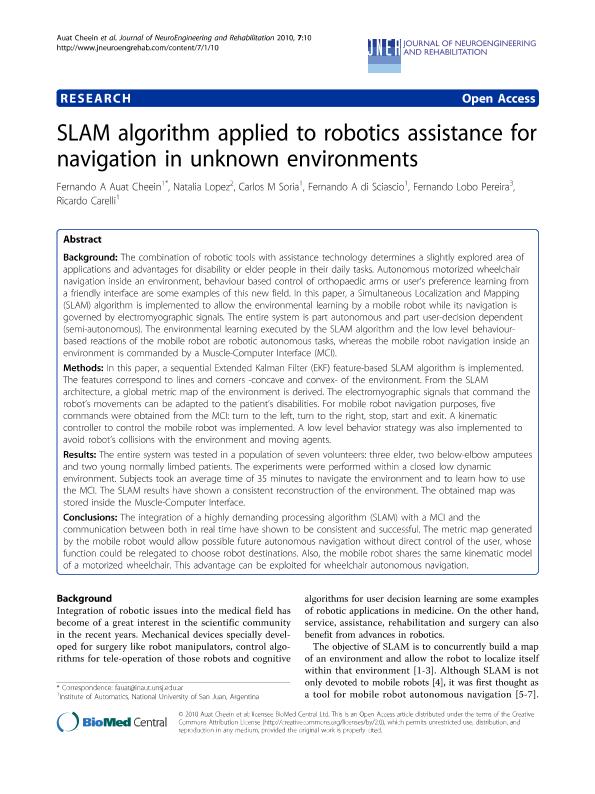Artículo
SLAM algorithm applied to robotics assistance for navigation in unknown environments
Auat Cheein, Fernando Alfredo ; Lopez, Natalia; Soria, Carlos Miguel
; Lopez, Natalia; Soria, Carlos Miguel ; Di Sciascio, Fernando Agustín; Lobo Pereira, Fernando; Carelli Albarracin, Ricardo Oscar
; Di Sciascio, Fernando Agustín; Lobo Pereira, Fernando; Carelli Albarracin, Ricardo Oscar
 ; Lopez, Natalia; Soria, Carlos Miguel
; Lopez, Natalia; Soria, Carlos Miguel ; Di Sciascio, Fernando Agustín; Lobo Pereira, Fernando; Carelli Albarracin, Ricardo Oscar
; Di Sciascio, Fernando Agustín; Lobo Pereira, Fernando; Carelli Albarracin, Ricardo Oscar
Fecha de publicación:
02/2010
Editorial:
BioMed Central
Revista:
Journal Of Neuroengineering And Rehabilitation (jner)
ISSN:
1743-0003
Idioma:
Inglés
Tipo de recurso:
Artículo publicado
Clasificación temática:
Resumen
Background. The combination of robotic tools with assistance technology determines a slightly explored area of applications and advantages for disability or elder people in their daily tasks. Autonomous motorized wheelchair navigation inside an environment, behaviour based control of orthopaedic arms or user's preference learning from a friendly interface are some examples of this new field. In this paper, a Simultaneous Localization and Mapping (SLAM) algorithm is implemented to allow the environmental learning by a mobile robot while its navigation is governed by electromyographic signals. The entire system is part autonomous and part user-decision dependent (semi-autonomous). The environmental learning executed by the SLAM algorithm and the low level behaviour-based reactions of the mobile robot are robotic autonomous tasks, whereas the mobile robot navigation inside an environment is commanded by a Muscle-Computer Interface (MCI). Methods. In this paper, a sequential Extended Kalman Filter (EKF) feature-based SLAM algorithm is implemented. The features correspond to lines and corners -concave and convex- of the environment. From the SLAM architecture, a global metric map of the environment is derived. The electromyographic signals that command the robot's movements can be adapted to the patient's disabilities. For mobile robot navigation purposes, five commands were obtained from the MCI: turn to the left, turn to the right, stop, start and exit. A kinematic controller to control the mobile robot was implemented. A low level behavior strategy was also implemented to avoid robot's collisions with the environment and moving agents. Results. The entire system was tested in a population of seven volunteers: three elder, two below-elbow amputees and two young normally limbed patients. The experiments were performed within a closed low dynamic environment. Subjects took an average time of 35 minutes to navigate the environment and to learn how to use the MCI. The SLAM results have shown a consistent reconstruction of the environment. The obtained map was stored inside the Muscle-Computer Interface. Conclusions. The integration of a highly demanding processing algorithm (SLAM) with a MCI and the communication between both in real time have shown to be consistent and successful. The metric map generated by the mobile robot would allow possible future autonomous navigation without direct control of the user, whose function could be relegated to choose robot destinations. Also, the mobile robot shares the same kinematic model of a motorized wheelchair. This advantage can be exploited for wheelchair autonomous navigation.
Archivos asociados
Licencia
Identificadores
Colecciones
Articulos(SEDE CENTRAL)
Articulos de SEDE CENTRAL
Articulos de SEDE CENTRAL
Citación
Auat Cheein, Fernando Alfredo; Lopez, Natalia; Soria, Carlos Miguel; Di Sciascio, Fernando Agustín; Lobo Pereira, Fernando; et al.; SLAM algorithm applied to robotics assistance for navigation in unknown environments; BioMed Central; Journal Of Neuroengineering And Rehabilitation (jner); 7; 1; 2-2010; 1-16
Compartir
Altmétricas



